Family is important to Jennifer and Justin Albright. Their parents, siblings, aunts, uncles and cousins all live within a mile or so of their West Hempfield Township home that features four acres of trees, gardens, an outdoor-living area, a screened porch, a swimming pool and hilly areas that are perfect for sledding. It’s provided them and their extended family with a way to stay connected – and entertained – over the past 14 months.
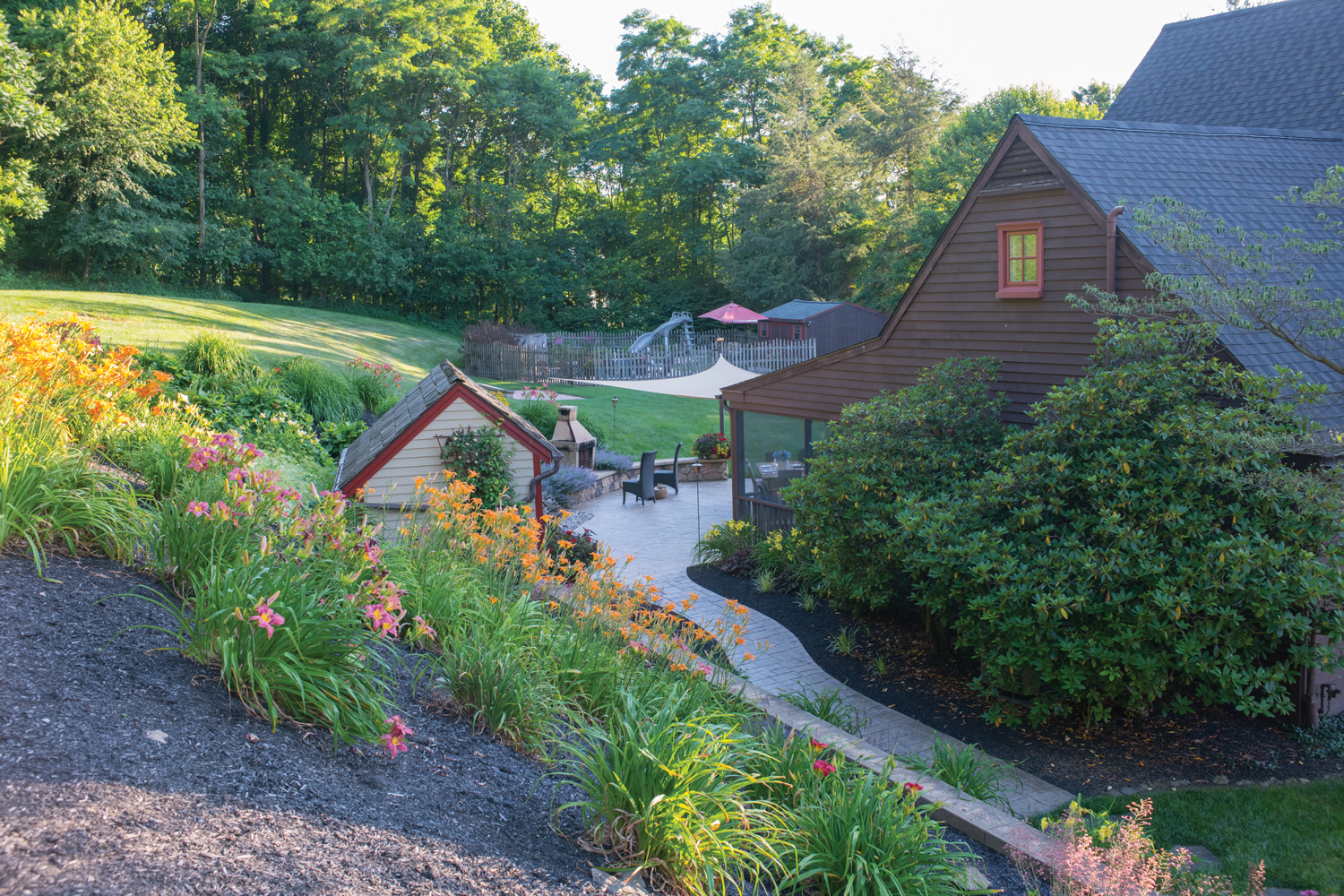
The Albrights’ four-acre property revolves around outdoor living and entertaining friends and family. On fall weekends, the patio is equipped with a television for watching football.
The manner in which Jennifer and Justin met and married is straight out of a Hallmark movie. The two lived about a quarter-mile from each other and carpooled to Our Lady of the Angels School in Columbia during the school year. They are both graduates of Columbia High School. However, their three-year age difference provided few opportunities to socialize. “Our mothers never tried to get us together, either,” Jennifer recalls.
That all changed on the night Jennifer was out with friends to celebrate her 21st birthday. Justin happened to be at the same bar and came over to the table to wish her happy birthday. “I think he bought me a drink, too,” she smiles. A week later, he called her for a movie date. “We just kept running into each other that summer,” she recalls.
Part of their developing bond was a love for the Susquehanna River. As children, each of their families had summer cabins along the river. “We grew up on the river and have always been big river people,” Jennifer notes, adding that Justin recently purchased a boat, which will allow them to spend more time on the Susquehanna this summer. “We’re either here,” she says of home, “or on the river.”
Despite the distance that separated them – Jennifer was a student at Penn State and then furthered her education at Slippery Rock, where she completed graduate work in physical therapy, while Justin, a graduate of Elizabethtown College, had launched his IT career locally – their relationship flourished. Justin made it a practice to send Jennifer a dozen roses every week.
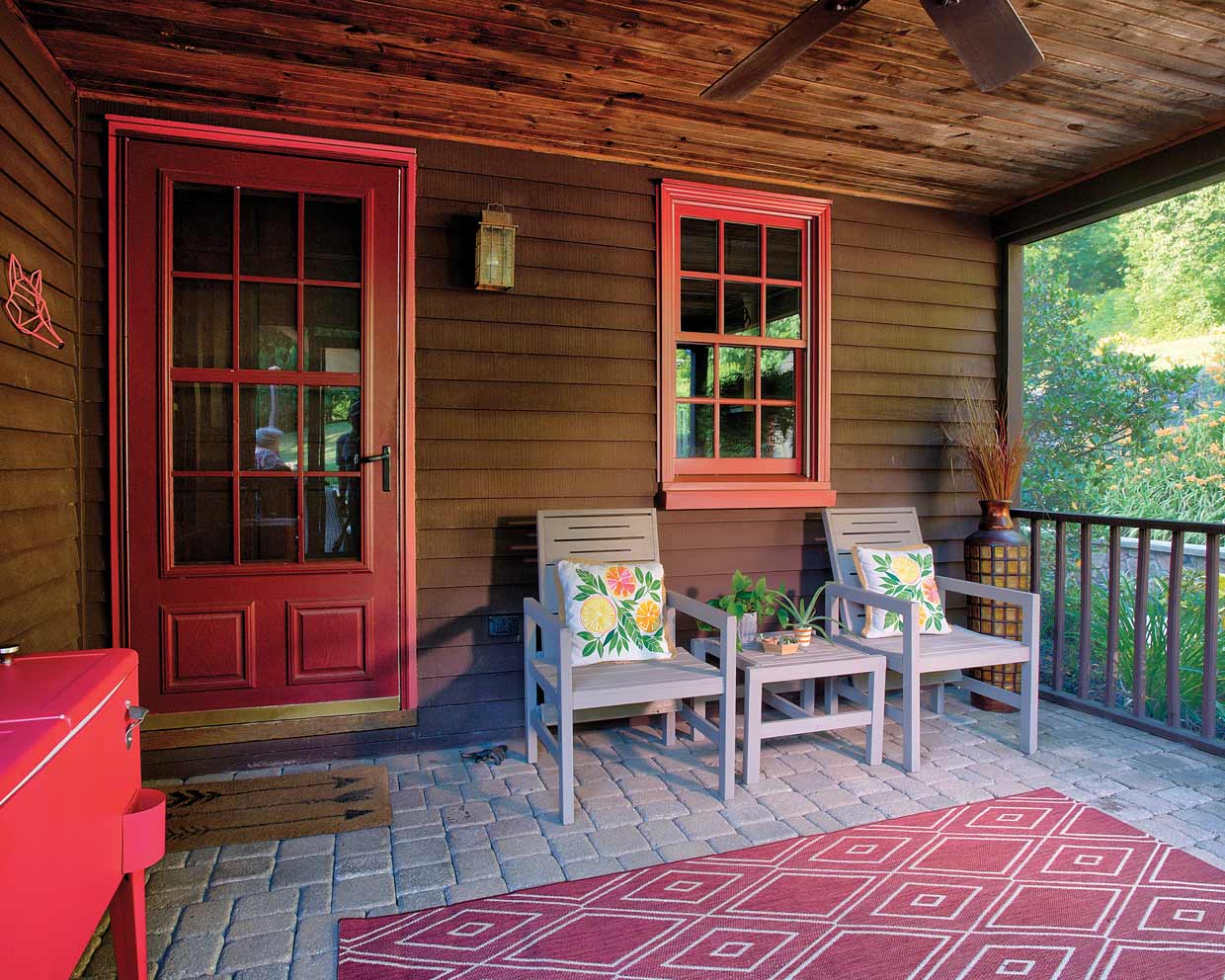
The screened porch provides an outdoor option for rainy days, as well as a quiet place to enjoy a glass of wine in the evening.
The two were wed in 2004. They began married life in a rowhouse Justin had bought in Columbia. “He bought it without me seeing it!” Jennifer says, adding that she approved of his choice because of the “character” that came courtesy of its centuries-old age. The arrival of two children prompted them to buy a newly built and larger house on the outskirts of town. The house never felt like “home,” Jennifer explains. “It just didn’t have any character,” she continues. “I like houses that have character.”
Fortunately, such a house existed nearby. Built in 1984, the New England-style saltbox appears to have been built closer to 1784. Jennifer and Justin immediately recognized that it would offer the character and qualities of what they envisioned as possibly being their “end-all, be-all house.” They looked at the house (several times), loved what they saw and bought it in November 2015. They spent the winter working on the interior of the house in an effort to transition the Colonial Williamsburg color scheme to modern farmhouse.
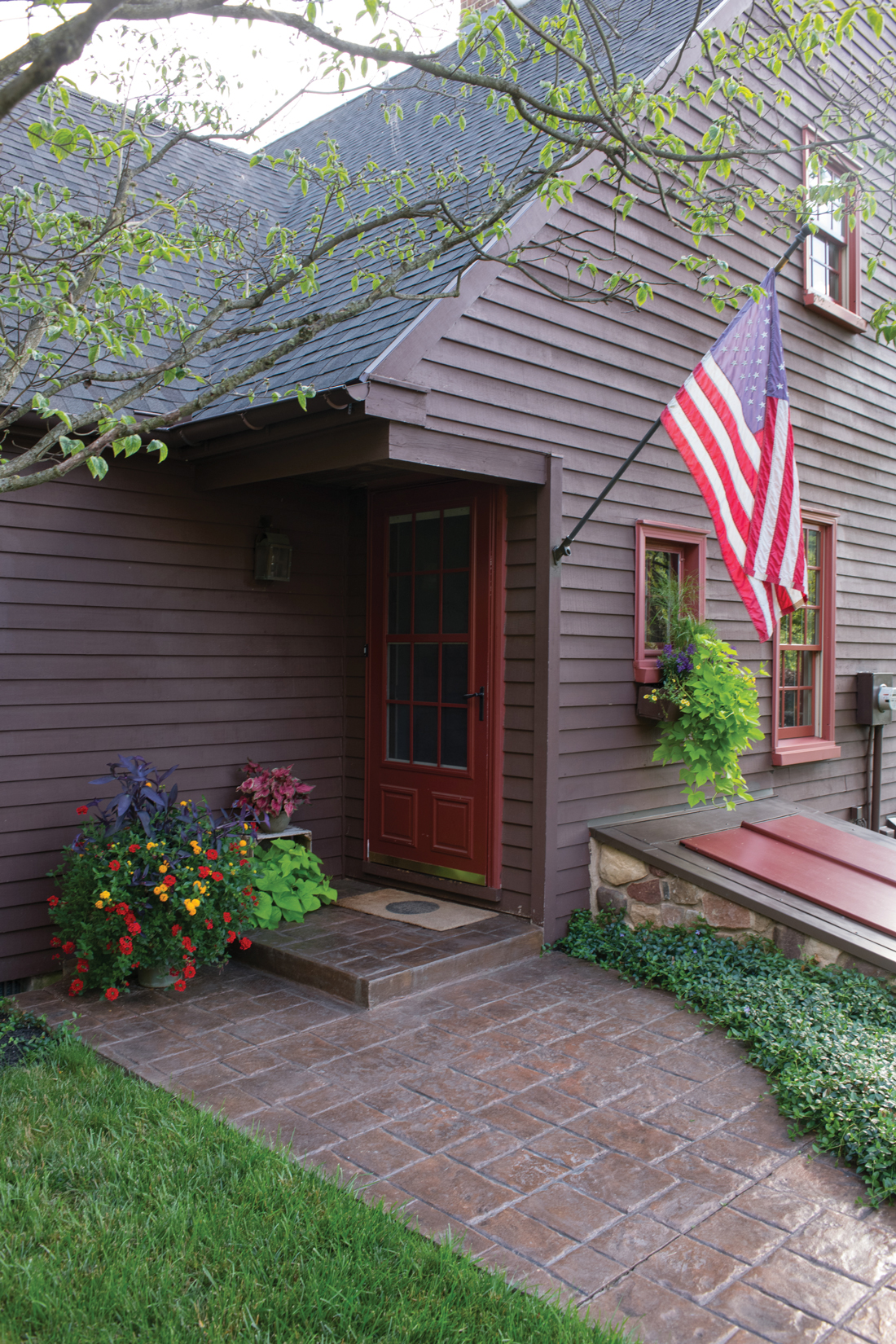
Painting the exterior of the house is the Albrights’ next home project. Jennifer hopes to change the color scheme to gray and white, which will reflect the modern farmhouse styling of the interior spaces.
Named after a wooden-lidded container that was used to store salt in colonial times, the saltbox is known for its steep roof that is longer in the back than it is in the front. The differentiating rooflines served multiple purposes. One had to do with taxation. It was Queen Anne’s policy to tax a homeowner according to how many stories his house had. Technically, the saltbox was one story, hence it was taxed as such. Another had to do with New England’s harsh winters – the steep slope at the rear of the house allowed snow to easily slide off. The third reason accommodated growing families – additions could easily be constructed on the back of the house.
The heyday of the saltbox was 1650-1830. Many survive today and are listed on city, state and federal historical registries.
When spring arrived, it occurred to them that they may have bitten off more than they could chew. “We weren’t prepared for the level of work that is required here,” Jennifer admits, explaining that preparing for the growing season requires 24 scoops of mulch. Justin, however, was game to take on the challenge and “jumped in head first,” relying on his long-held experience with aquariums and his genetically gifted green thumb. “My grandmother and mother have always been into gardening,” he notes. “I find that working in the garden and even mowing the lawn are very therapeutic.” According to Jennifer, her husband is “also naturally curious and likes to constantly learn new things.”
Jumping In
The first thing on Justin’s agenda was revamping the water garden. He thinned out and repotted the myriad of plants that were growing in and around the pond, making room for fish. While the Albrights contemplated stocking it with koi, they took the inexpensive route (goldfish) because of predators such as herons and raccoons. Justin also devoted the first year in the house to cataloging all the plants that grow on the property.
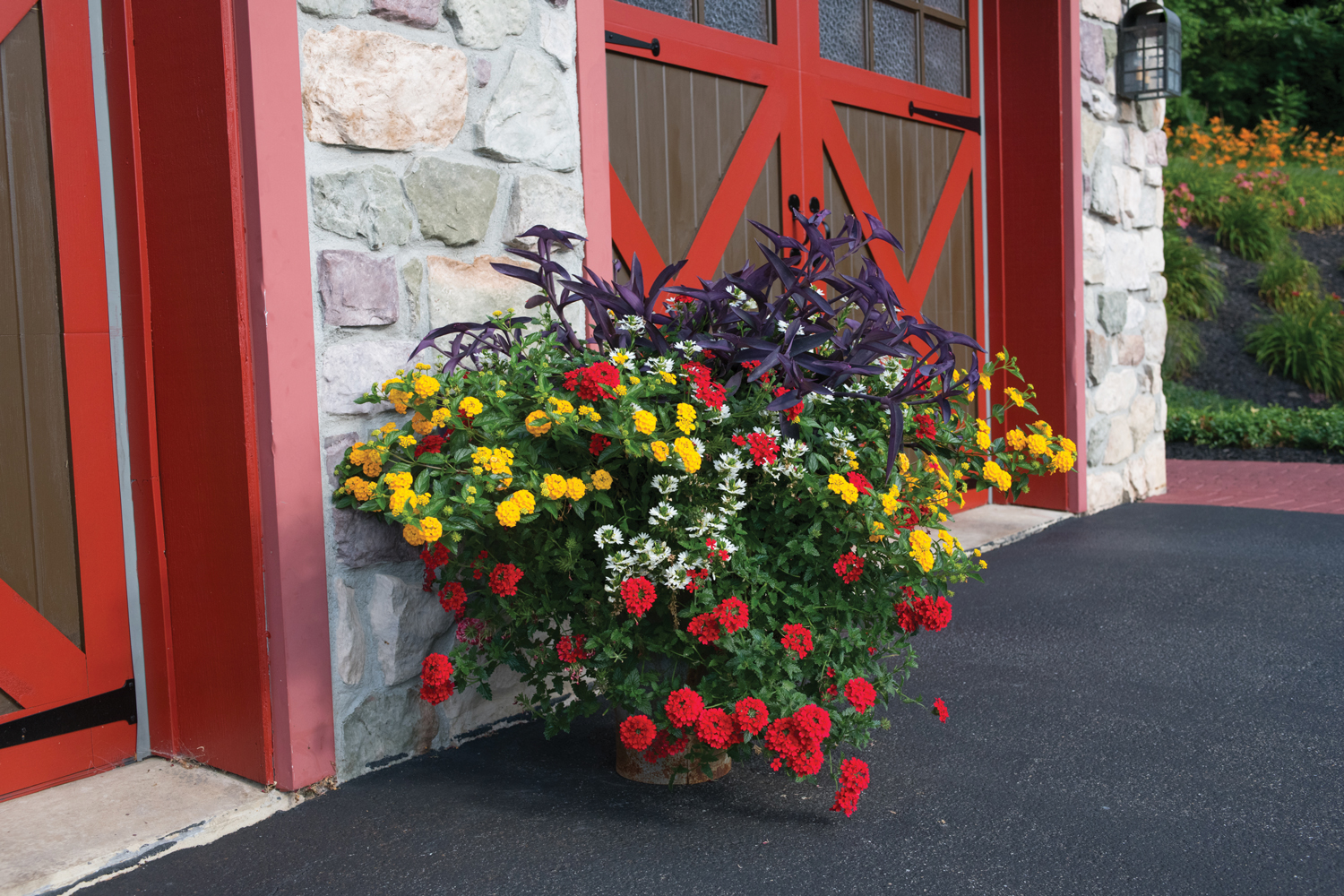
Jennifer relies on Eve’s Garden near Millersville to create her larger container gardens. This one is composed of lantana, verbena and purple heart.
Justin also delved into vegetable gardening and began experimenting with a German raised-bed method called hügelkultur, which is also known as mound or hill culture. Used for centuries by German and eastern European gardeners, the methodology entails piling rotting wood and plant debris and topping it with compost and soil.
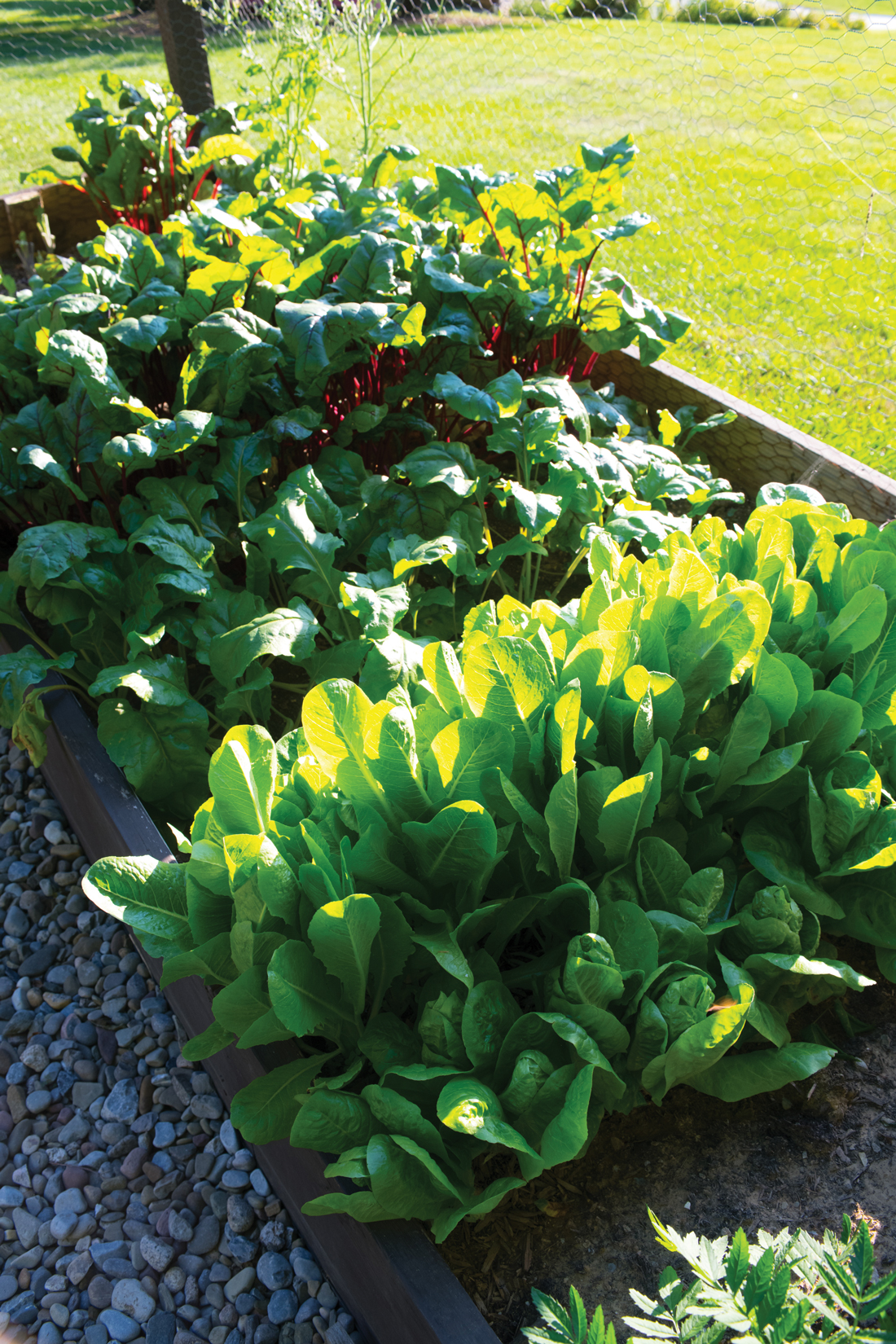
Justin’s hügelkultur-style beds in his vegetable garden are used to grow Swiss chard, radishes, lettuces, herbs and other edibles. Another bed is dedicated to salsa ingredients, while in another, the theme is hot peppers.
Justin utilizes hügelkultur to grow all sorts of vegetables, lettuces and herbs. “We eat lots of salads in the summer,” Jennifer says of the bounty the garden provides.
The garden is also home to a bed of hot peppers. “I’ve always liked hot sauce and now I can make my own,” he remarks. Another specialty garden in which tomatoes, peppers, onions and herbs are grown, provides the makings for salsa.
Justin also sows his own seeds, which he uses to make seed packets. “Our laundry room becomes a growing room in late winter and early spring,” Jennifer adds.
There’s also an orchard in progress that is filled with apple, peach and cherry trees. “He calls it his ‘farmette,’” Jennifer says of the area Justin has carved out for his garden and orchard.
The method could also be described as the ultimate in recycling, as many gardeners start the process in the fall during the clean-up process and by spring they have beds ready for planting. The end result is a super-fertile and moisture-retaining bed, earning the name “living sponge.” Because of the heat that is generated, the growing season can get a jump start in the spring and last into the fall.
A good resource is rurallivingtoday.com/gardens/hugelkultur-gardening.
Baby Steps
As for Jennifer, gardening was more akin to taking baby steps. After all the tulips and daffodils she “inherited” bloomed the first spring after the Albrights moved to the property, she was uncertain what she should do with the unsightly foliage. In the beginning she followed an aunt’s instructions to roll the foliage into small mounds and bound them with rubber bands. “That was so time-consuming!” she says. “Now, I just cut everything back and hope for the best.”
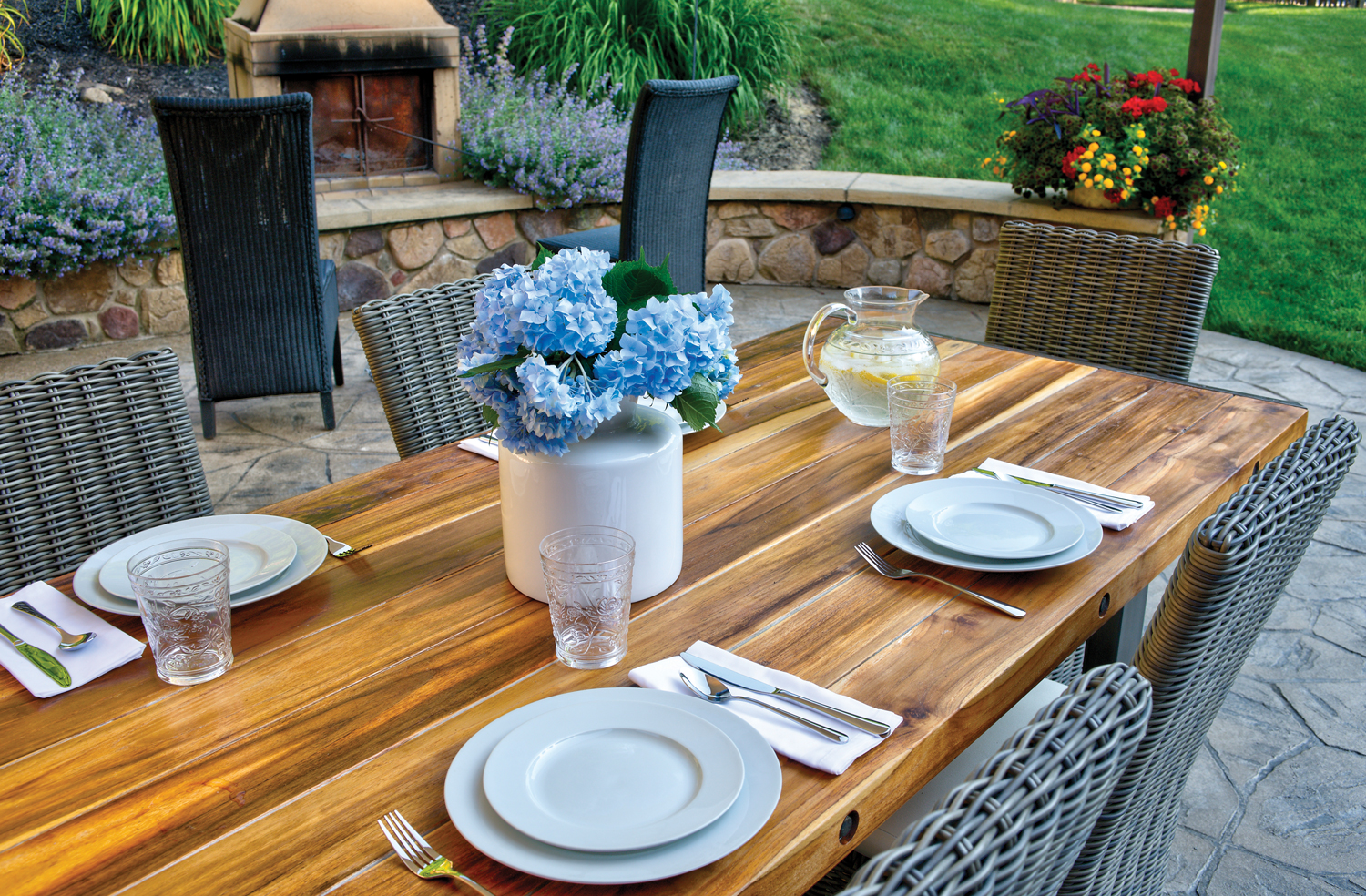
The patio includes a dining area and outdoor kitchen. The grill/fireplace is used primarily for roasting marshmallows. Because of Jennifer and Justin’s work schedules, their mothers, Cathy Jones and Joni Albright Groom, volunteered to style the area for the photo shoot.
She has also become a student of Eva Diller, who owns Eve’s Garden near Millersville. “She’s taught me a lot,” says Jennifer, who now derives pleasure from tending to her gardens. “There’s just something about having your hands in the dirt,” she says.
She’s also learned that in some instances, it’s better to put some aspects of gardening in the capable hands of the pros. “Eve’s does all my containers,” she says of the five large containers she tends to – with the aid of Jack’s Petunia Feed – each summer. “They bring me joy,” she says of the colorful combinations that have become Jennifer’s “annual” Mother’s Day gift to herself.

Soon after moving to the property, Justin catalogued all the plants. Here, hosta and hummingbird mint bring color to a bed inside the pool enclosure.
Learning Curves
There were a few learning curves along the way. For example, the expansive, sun-swept patio and outdoor kitchen were not conducive to afternoon barbecues. After exploring several options that would shade the patio (and adjacent fish pond), they found the perfect solution – a shade sail – on Amazon that makes dining and socializing outside enjoyable.
They also learned why the lounge area adjacent to the pool was “planted” in astro turf. “We replaced it with real grass and the first time we mowed it, the clippings ended up in the pool,” Jennifer explains. The astro turf has since made a comeback.
A Home for All Seasons
Once the Albrights became in-tune with maintaining the property – they do a majority of the work themselves – they developed a rhythm that enables them to enjoy it as well. “All the hard work gets done in the spring and then we can enjoy it the rest of the year,” Jennifer explains. “It truly is beautiful here all four seasons of the year. In the summer, we’re outside all the time and even if it rains, we have the screened porch. In the fall, the trees provide a beautiful backdrop. On fall weekends, we bring a television outside and watch football. We also like to hike in the woods that’s behind the house. In the winter, it’s so beautiful and peaceful when it snows. It’s also a great place for sledding.”
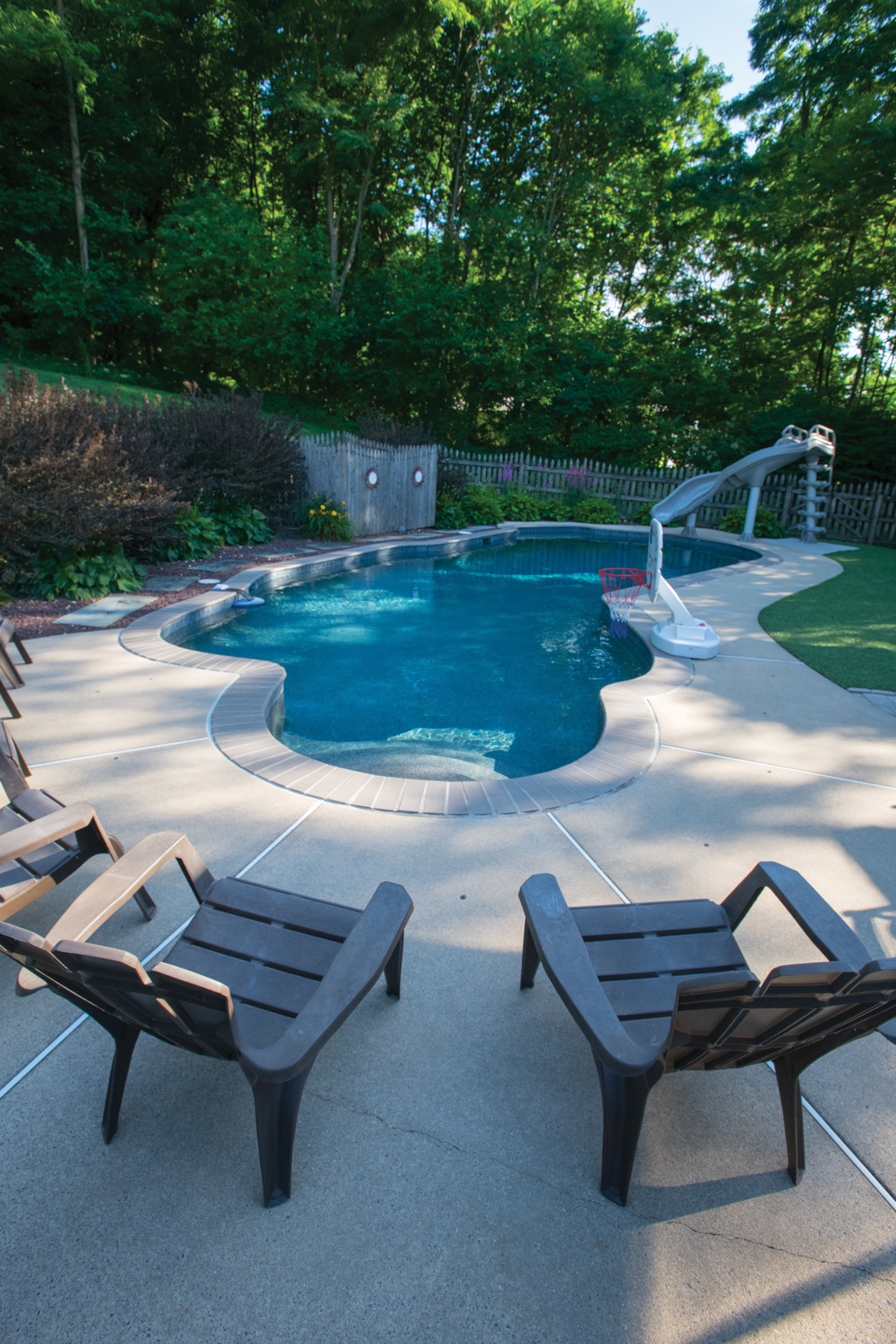
The pool provided welcome entertainment from the pandemic last summer. The grassy area of the pool deck is actually covered with care-free astro turf.
Life has become busier as of late. The Albrights’ 13-year-old son is a member of a club soccer team, which travels on weekends for games. “Mostly to the Philly area,” says Jennifer. Their 11-year-old daughter is involved in dance, cheerleading and basketball. “Our moms help out a lot,” notes Jennifer. In fact, the dynamic duo – Cathy Jones and Joni Albright Groom – volunteered to provide styling for the patio on the day these pictures were taken because Jennifer, who is a physical therapist and clinic director at CPRS Physical Therapy in Columbia, had to work until 7 p.m.
The year has also been one of change for Justin, who works in IT for WellSpan Health. He’s been working from home since March 2020 and sees it continuing indefinitely. He’s good with the change in scenery, as it eliminates commuting to York and provides him with more time in his garden.
There’s also a home project looming – the exterior of the house will need painted soon and Jennifer would love to have the color scheme echo the modern-farmhouse vibe of the interior. “Maybe change it to gray and white,” she muses.





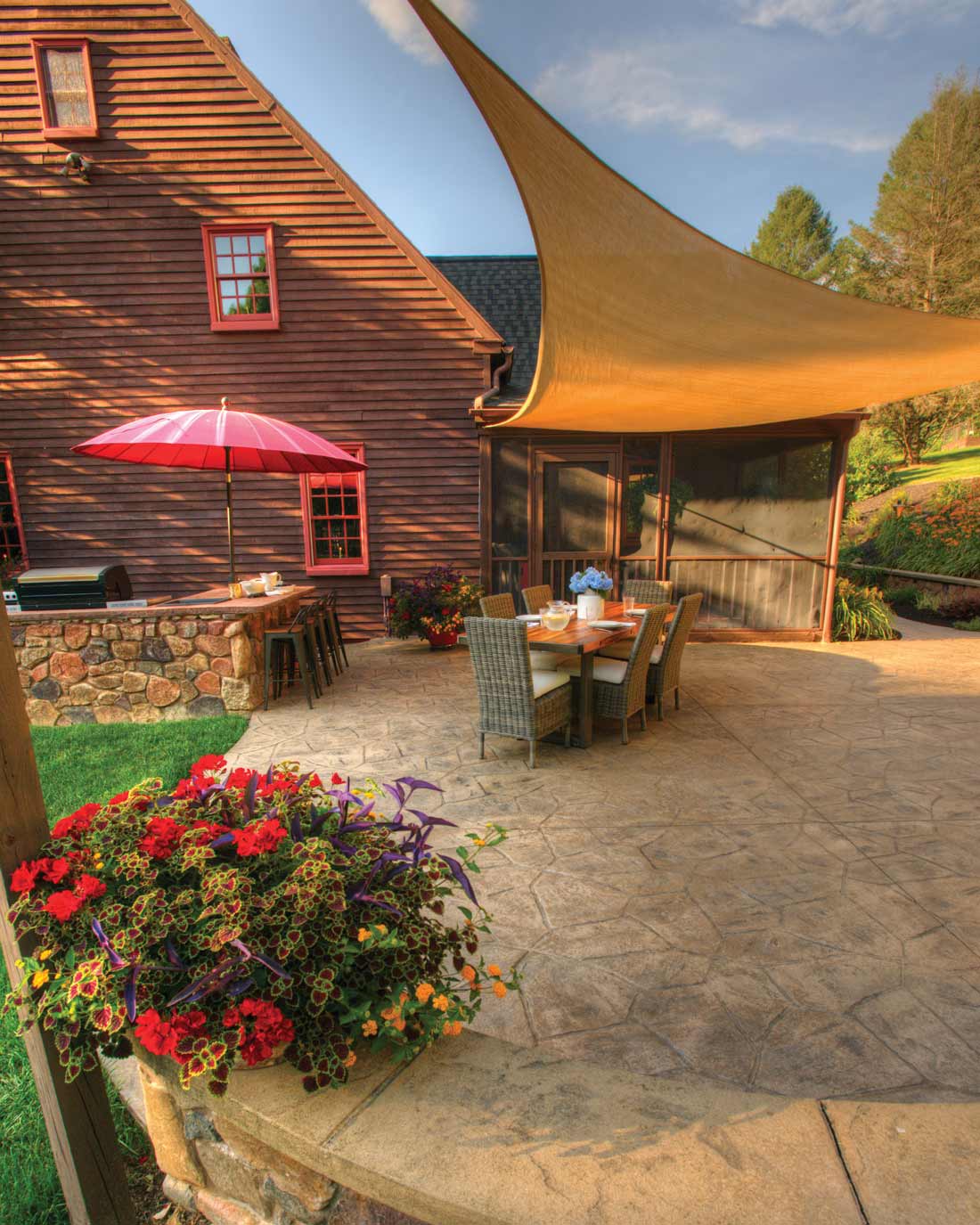

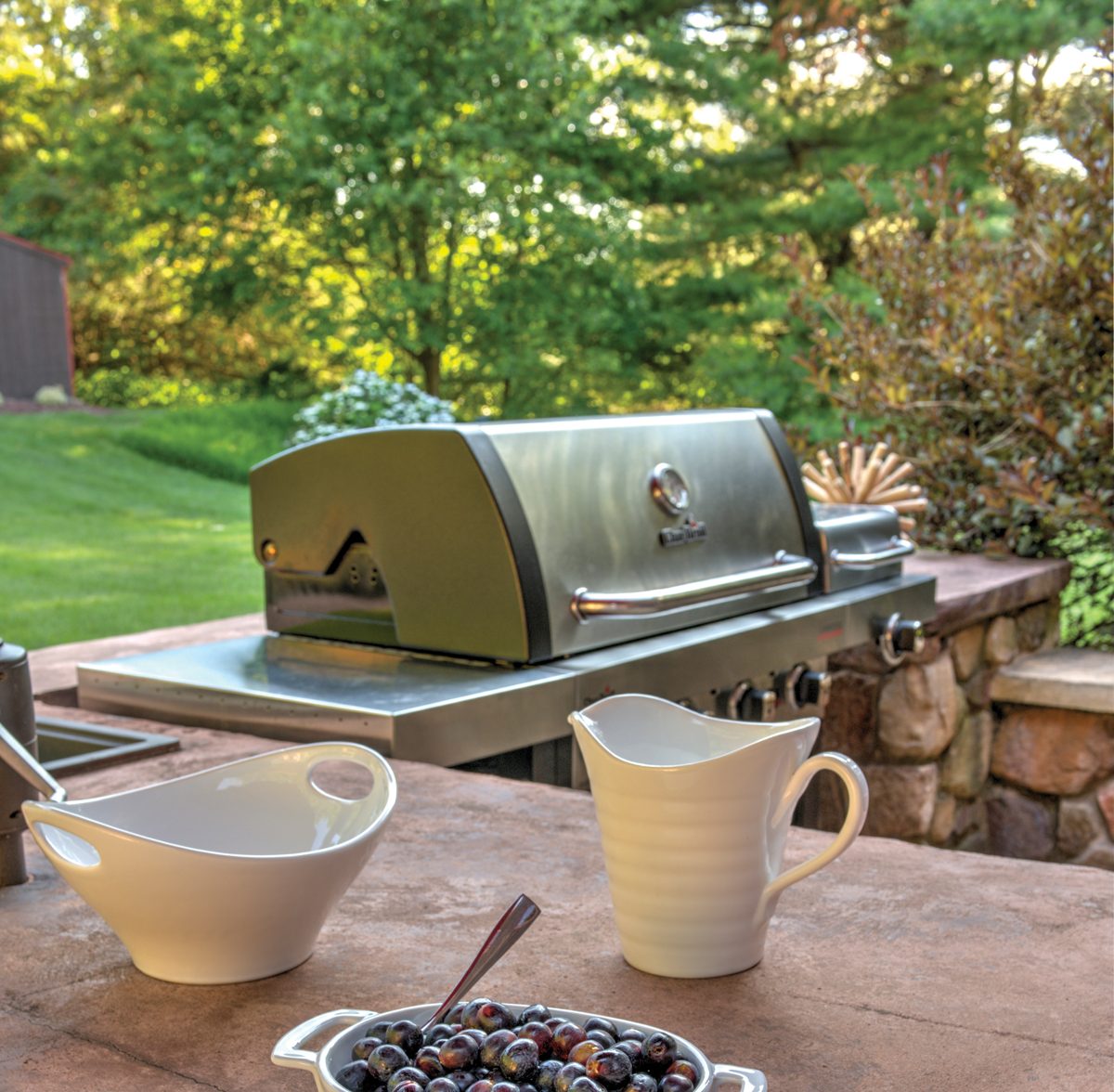
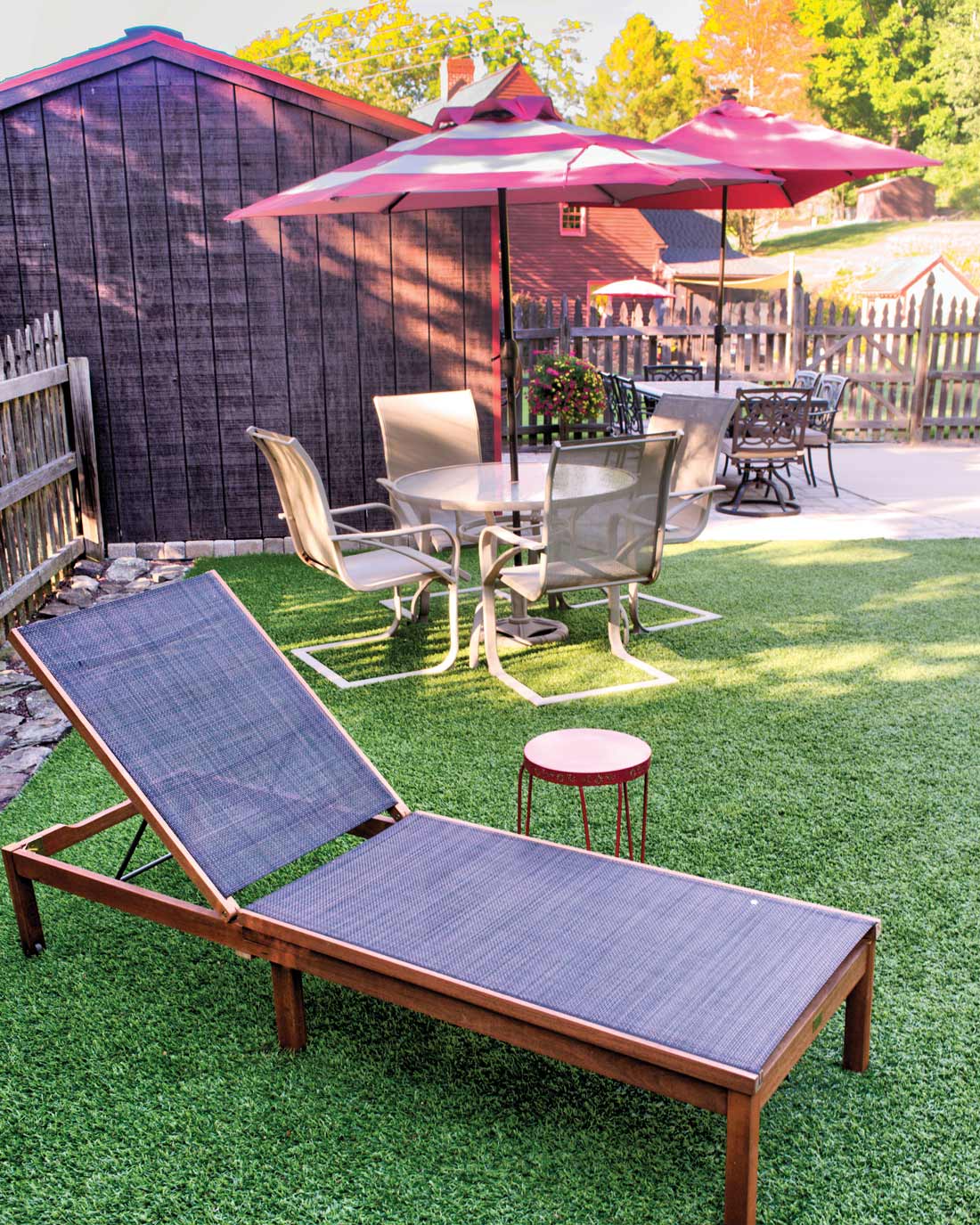
SHARE
PRINT